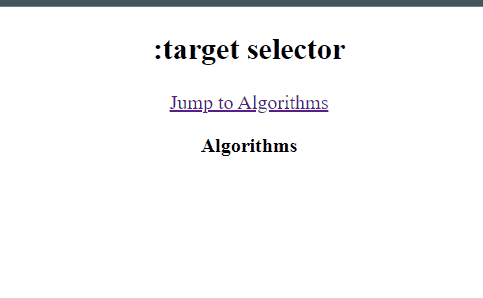CSS :target Selector
Last Updated :
05 Jul, 2023
The target selector is used to represent a unique element (the target element) with an id matching the URL’s fragment. It can be used to style the current active target element. URLs with a # followed by an anchor name link to a certain element within a document. The element being linked to is the target element.
Syntax:
:target {
// CSS Property
}
Example 1: In this example, The :target selector applies CSS styles to the target element specified in the URL fragment, allowing customization based on the target element.
HTML
<!DOCTYPE html>
<html>
<head>
<title>CSS | :target Selector</title>
<style>
/* CSS property of target selector */
:target {
border: 2px solid #D4D4D4;
background-color: green;
color: white;
padding: 10px;
font-size: 20px;
}
</style>
</head>
<body style="text-align:center">
<h2>
:target selector
</h2>
<p>
<a href="#geek">
Jump to Algorithms
</a>
</p>
<p id="geek">
<b>Algorithms</b>
</p>
</body>
</html>
|
Output:

Example 2: In this example, The :target selector is used to styling the targeted element based on the URL fragment, showing content dynamically.
HTML
<!DOCTYPE html>
<html>
<head>
<title>:target Selector</title>
<style>
.tab div {
display: none;
}
.tab div:target {
display: block;
color: white;
background: green;
padding: 5px;
margin: 20px 5px;
}
</style>
</head>
<body style="text-align:center">
<h2>
:target selector
</h2>
<div class="tab">
<a href="#geek">Geeks Classes</a>
<div id="geek">
<h3>Welcome to Geeks Classes.</h3>
<p>Hello World!</p>
</div>
</div>
</body>
</html>
|
Output:

Supported Browsers: The browser supported by :target Selector are listed below:
- Apple Safari 1.3
- Google Chrome 1.0
- Edge 12.0
- Firefox 1.0
- Opera 9.5
Share your thoughts in the comments
Please Login to comment...